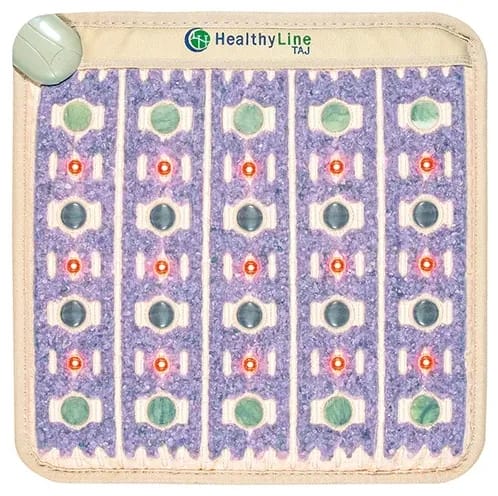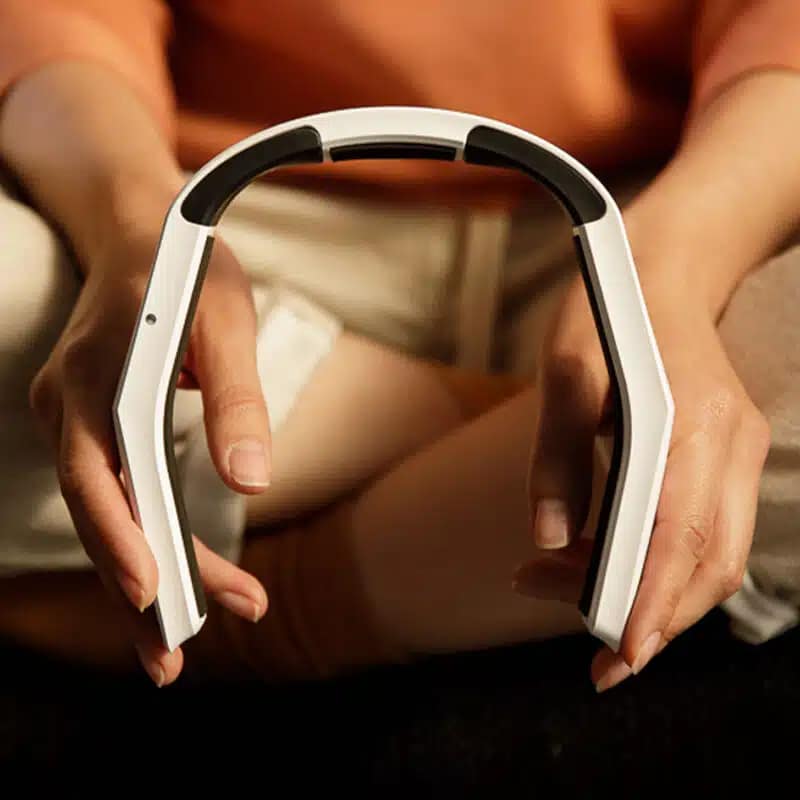PEMF for Sleep: The Science, The Best Devices & My Weekly Plan

Hello and welcome to my article about how to use PEMF for sleep improvement.
Do you struggle to fall asleep or to stay asleep through the night?
You are not alone.
My name is Marco Gentile, I’m a wellness professional with over 10 years of experience in restorative and longevity therapies. Right now, I work at the Burke Williams Spa – Health, Wellness & Fitness Center in Los Angeles, California.
Did you know that about one-third of adults regularly get less sleep than they should?
Having assisted hundreds of clients, I’ve seen how PEMF (Pulsed Electromagnetic Field) therapy can greatly improve sleep for those who need it.
Today, I’ll share how PEMF for sleep can significantly enhance the quality of your rest, helping you fall asleep faster, stay asleep longer, and wake up feeling more refreshed. Improved sleep is just one of the many benefits a PEMF mat can provide.
I’m excited to share with you how this incredible technology uses electromagnetic fields to potentially revolutionize your sleep quality!
Let’s dive in!
🔬 PEMF for Sleep: How Does It Work?
🧠 Brainwaves
Before artificial lighting changed our lives, humans synced well with the Earth’s natural electromagnetic field. The field resonates at frequencies that hover around 7.83 Hz, called the Schumann resonance.
There’s a reason why people often sleep better when camping or spending time in nature. You’re literally tuning back into Earth’s natural frequency!
If you have read my article on how to use PEMF for meditation, you may already be familiar with the process of “brainwave entrainment”. If not, I’ll quickly explain it.
The human brain naturally produces electromagnetic waves, called “brainwaves”. They resonate at a specific frequency (measured in Hertz). Different frequencies correspond to different statuses of the brain. Check the infographic below to see what they are.

The brain has the natural tendency to synchronize with the external frequencies it is exposed to. When you are in nature, you will feel calmer because your brain is tuning into the Schumann resonance, at 7.83 Hz.
If you are at a rock concert, you will feel more energized and active because the frequencies your brain is exposed to are much higher.
PEMF will help you to take advantage of this process, producing the electromagnetic frequencies that correspond to the sleeping process:
- Sleep Initiation: Alpha Waves (8- 12Hz)
- Light Sleep: Theta Waves (4-8 Hz)
- Deep Sleep: Delta Waves (0.5-4 Hz)
Pro Tip: Whether you find it hard to fall asleep or to reach a deep sleep, you should select the PEMF frequency that corresponds to the result you want to achieve.
The neural entrainment process has been proven by several scientific studies. You can check them all in the reference section at the end of the article 1 2 3 4
😴 Fighting Insomnia Naturally
There is strong scientific evidence that PEMF therapy can help with insomnia. In 2023, researchers conducted a high-quality clinical trial across multiple centers to test how effective and safe PEMF is for treating insomnia.
The study was double-blind, randomized, and included a sham (fake) comparison treatment. It involved 153 people—76 received PEMF therapy, and 77 received the sham treatment—over four weeks, followed by a one-week check-in.
The results were impressive:
- People using PEMF showed steady improvements in their Insomnia Severity Index (ISI) scores over the whole study. In contrast, the sham group only had a small improvement in the first week.
- By the end of the treatment, 69.7% of the PEMF group no longer had clinically significant insomnia (measured by ISI ≤9), while only 35.1% of the sham group improved that much.
- A week after treatment ended, 75% of the PEMF group still showed benefits.
Other sleep measurements, like the Pittsburgh Sleep Quality Index and sleep diary data (sleep latency, sleep efficiency, and real sleep time), also showed significant improvements in the PEMF group compared to the sham treatment.
Another clinical trial from 2001 tested the effectiveness of PEMF for insomnia. The active treatment group showed a significant improvement in all sleep-related factors.
Although the placebo group had some improvement, the difference between the two groups was highly significant.
About 70% of patients in the active group experienced substantial or complete symptom relief, with no reported adverse effects.
🧘♂️ Reducing Anxiety
One of the most surprising benefits I’ve come across is how PEMF therapy affects anxiety-related sleep issues. I have tried this firsthand, and the results have been quite impressive.
Reducing anxiety can help with sleep because it calms the mind and body, making it easier to relax and fall asleep. When anxiety is lower, stress hormones decrease, allowing for a more restful, uninterrupted sleep cycle.
Without the constant worry or racing thoughts, the body can enter the deep, restorative stages of sleep more easily.
PEMF for Sleep: Summary Infographic

🤖 PEMF For Sleep: Choosing The Right Device
I’ve tried many devices and made some costly mistakes. Now, I’ve learned what truly matters when picking a PEMF device to improve sleep.
When it comes to picking the best PEMF device to sleep better, you’ve got several options.
1. PEMF Mats

PEMF mats are fantastic for sleep because they support your whole body while you’re lying down. They are the most obvious choice. You can put them below your mattress or directly lie down on them.
A big plus is that you can use them for many other things beyond sleeping: athletic and muscle recovery after a workout session (if that’s your thing), relieving your back pain, and even treating arthritis, osteoporosis, and neuropathy
The downsides? They aren’t cheap, and they aren’t portable, as they need to be plugged in, besides being quite heavy and bulky. Luckily, that’s rarely a problem when you use them in the comfort of your home.
If a PEMF mat is the right choice for you, check out my article on the 26 Best PEMF Mats of 2025. I’m pretty sure you’ll find what you are looking for! Below are the mats that ranked top 3 in my comparison:

HealthyLine JET

OMI PEMF Beyond

Therasage TheraPro
2. PEMF Pillows

PEMF pillows are a popular choice for enhancing sleep with PEMF therapy. The reason is quite obvious: they are pillows!
Their main benefit is convenience. But they are also quite useful for purposes beyond sleep. They are widely used for skin-care, but you can also place them on a footstool and rest your legs while watching TV on the sofa.
If you think a PEMF pillow could be a good option for you, please check my guide on the best PEMF pillows for sleeping. If you are curious about who the winner is, I’ll give you a quick peek at the final results:

Sedona TimmyZZZ

HealthyLine TAO Matrix

OmniPEMF NeoRhythm Tube
3. PEMF Pads

PEMF Pads are used for more targeted therapy. They are smaller and designed to be applied directly to specific areas of the body, such as the neck, lower back, or feet, which is helpful if you have plantar fasciitis.
You can place them below your normal pillow. The advantage of a PEMF pad is that, unlike PEMF pillows, you can use it for several treatments other than for sleep improvements.
If you think a pad can be a suitable option for you, just check my article on the best PEMF pads available on the market. It will certainly help you to find the one that suits your needs. Here’s the final result of my review:

HealthyLine TAJ Pad

OmniPEMF NeoRhythm

ApeBorn Fitness PEMF Infrared Mat
4. PEMF Wearables

Most PEMF wearables, like bands or ring-shaped devices, are hardly suitable for improving your sleep.
There’s an exception, though: the OminiPEMF NeoRhythm. It features a U-shape that allows you to put it directly on your head. It also has a preset program designed specifically to help you sleep better.
You can also buy a custom headband cover to stabilize the device on your head. It is possible to keep it on your head while you sleep, though it might be a little awkward to wear it at night.
Interested in exploring wearable PEMF devices? My buying guide highlights the best portable PEMF devices out there, so you’re sure to find the right fit for your needs!
What features do I need to look for?
Speaking of features – this is where things get interesting! The most effective sleep-focused PEMF devices I’ve worked with share some key characteristics. They should definitely have:
- Adjustable frequency settings that go as low as 0.5 Hz
- Sine waveforms (not square or trapezoidal – trust me on this one!)
- Auto shut-off features or preset programs that shut the device off when the program is over. Because nobody wants to wake up to turn off their device!
📅 PEMF Therapy for Sleep Improvement: My Weekly Schedule
Improving your sleep with PEMF therapy is easier than you think. I’ve designed a simple weekly schedule that takes the guesswork out of it so you can relax and let the technology do the work.
Are you new to PEMF? Let me quickly define frequency and intensity:
-
Frequency, measured in Hertz (Hz), refers to the number of electromagnetic pulses delivered per second by a PEMF device. In simple terms, it determines how fast the pulses occur.
-
Intensity represents the strength of the electromagnetic field emitted by the PEMF device. Most devices use Gauss (G) and MicroTesla (µT) in their user manual and controllers or phone apps. So I have included both in the table. (100µT = 1G)
Just follow the plan, and within two weeks, you’ll likely notice deeper, more restful sleep. No more tossing and turning, just pure relaxation.
| Day | Frequency | Intensity | Duration | Time | Notes |
|---|---|---|---|---|---|
| Monday | 0.5–4 Hz | 50 μT 0.5 G | 20 min | 1h before bed | Focus on Delta waves for deep sleep induction. |
| Tuesday | 4–8 Hz | 30 μT 0.3 G | 25 min | 1h before bed | Use Theta waves to promote relaxation and reduce anxiety. |
| Wednesday | No Therapy | Allow the body to adapt; focus on other relaxing activities like meditation. | |||
| Thursday | 0.5–4 Hz | 80 μT 0.8 G | 30 min | 1h before bed | Increase intensity slightly for deeper restorative effects. |
| Friday | 8–14 Hz | 40 μT 0.4 G | 20 min | Early evening | Use Alpha waves to reduce stress and prepare for the weekend. |
| Saturday | 0.5–4 Hz | 50 μT 0.5 G | 30 min | Evening | Reinforce Delta wave therapy for consistent deep sleep improvement. |
| Sunday | No Therapy | Recovery day: Focus on maintaining a regular bedtime routine. |
-
Duration: The therapy plan should be followed for an initial cycle of 6 weeks, after which users can evaluate improvements in sleep quality.
-
Maintenance: After the initial cycle, reduce sessions to 3 times per week (e.g., Monday, Thursday, Sunday) to maintain benefits.
Flexible Guidelines for Daily Use
Hate sticking to a strict schedule? Don’t stress! With these flexible PEMF therapy suggestions, you can still see great results without the pressure. Consider these tips as guidelines that you can incorporate into your daily routine.
- Frequency Range:
- Use frequencies between 3 Hz (for deep sleep) and 7 Hz (for relaxation and light sleep).
- Stick to lower frequencies in the evening to align with natural brainwave patterns for sleep.
- Intensity:
- Keep intensity low at 20 µT / 0.2 Gauss, as higher intensities are unnecessary for sleep improvement.
- Session Duration:
- Use the device for 30 minutes per session, ideally in the evening, about one hour before bedtime.
- Consistency:
- Aim for at least 4 sessions per week for optimal results, but allow rest days to prevent overstimulation.
- Environment:
- Pair therapy with a calm environment: dim lighting, no screens, and a cool room temperature. White noise is also a very common choice.
- Combination with Lifestyle Adjustments:
- Incorporate relaxation exercises like yoga or meditation after PEMF sessions.
- Avoid caffeine or heavy meals in the evening.
- Consider melatonin-rich foods like cherries or almonds to complement therapy.
By following these flexible guidelines or the structured weekly plan, users can effectively enhance their sleep quality using PEMF therapy while tailoring it to their personal needs and schedules.
In the end, PEMF therapy can be very helpful, but it should be approached carefully. Learn from my experience: do your homework, start slow, and always ask a doctor for help. Your body will thank you!
🙋FAQs
PEMF therapy works differently from traditional sleep aids. While it may enhance melatonin production and promote relaxation, it’s not necessarily a replacement for supplements or sleep-enhancing devices. Instead, it can be used alongside other natural sleep aids for a more holistic approach to better rest.
Results vary depending on the person and the PEMF settings used. Some people notice deeper sleep within a few days, while others may take 2–4 weeks of consistent use before experiencing significant improvements. Keeping a sleep journal can help track changes and optimize your PEMF routine.
PEMF therapy is safe for most individuals, but not recommended for those with pacemakers, insulin pumps, or other implanted electronic devices. Pregnant women should also avoid these treatments. For complete information about risks, side effects, and safety guidelines, please see our comprehensive article on PEMF therapy contraindications.
🔬Scientific Evidence

ABOUT THE AUTHOR
Marco Gentile
Marco Gentile (CHC, CMT, CTP, CETS) is a seasoned wellness professional with over 10 years of experience helping clients achieve optimal health and longevity. Currently, he works at the Burke Williams Spa – Health, Wellness & Fitness Center in Los Angeles, where he continues to inspire and support individuals on their wellness journeys.







